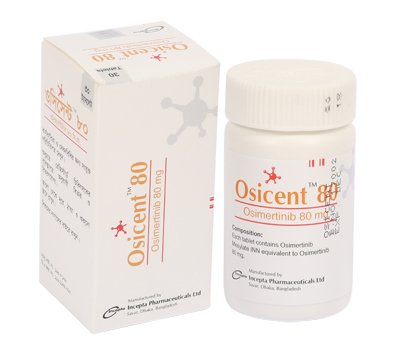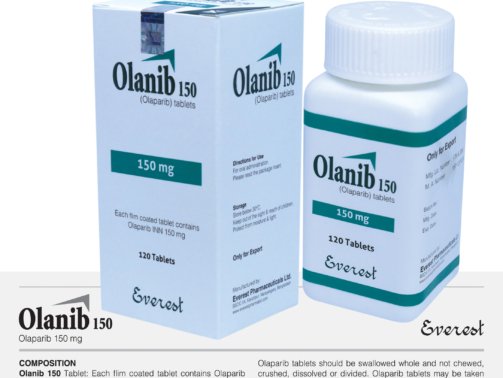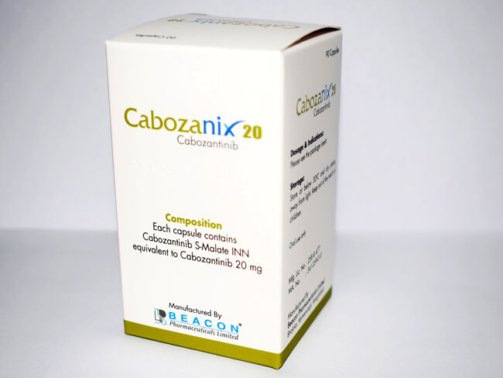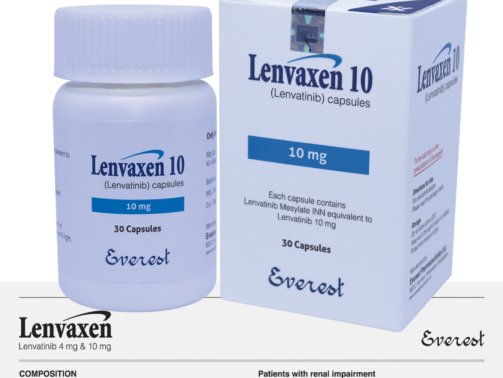Osimertinib 80 mg (Tagrisso)
0.00$
Osimertinib is kinase inhibitor of the epidermal growth factor receptor (EGFR), which binds irreversibly to certain mutant forms of EGFR (T790M, L858R, and exon 19 deletion) at approximately 9-fold lower concentrations than wild-type. In cultured cells and animal tumor implantation models, osimertinib exhibited anti-tumor activity against non-small cell lung cancer (NSCLC) lines harboring EGFR-mutations (T790M/L858R, L858R, T790M/exon 19 deletion, and exon 19 deletion) and, to a lesser extent, wild-type EGFR amplifications.
Osimertinib, sold under the brand name Tagrisso, is a prescribed drug mainly utilized for treating specific forms of non-small cell lung cancer (NSCLC). Its design is aimed specifically at tumors with certain mutations in the epidermal growth factor receptor (EGFR) gene, especially the T790M mutation and other activating mutations. Produced by AstraZeneca, Tagrisso has emerged as a foundational treatment for eligible patients, providing better outcomes than previous therapies.
Mechanism of Action
Osimertinib falls under the category of tyrosine kinase inhibitors (TKIs). It functions by selectively attaching to mutated variants of the EGFR protein present in cancer cells. Mutations in EGFR cause a lack of control over cell division and the proliferation of tumors. Osimertinib inhibits these faulty proteins, thereby blocking signals that promote the growth and spread of cancer cells. Crucially, it spares normal (non-mutant) EGFR to a considerable extent, which helps to lessen side effects in comparison to earlier generation EGFR inhibitors.
Indications
Tagrisso has received approval for the following applications:
First-line therapy for patients with metastatic NSCLC whose tumors have EGFR exon 19 deletions or exon 21 (L858R) mutations.
Management of patients with metastatic NSCLC who are positive for the EGFR T790M mutation (identified via an FDA-approved test) and whose condition has worsened following treatment with EGFR TKIs.
Patients with early-stage (IB, II, or IIIA) NSCLC who have undergone complete tumor resection and possess EGFR mutations should receive adjuvant therapy.
These endorsements rely on considerable enhancements in progression-free survival and overall survival observed in clinical studies.
Dosage and Administration
The recommended dosage of Tagrisso is 80 mg taken orally once daily. It can be ingested with or without food. The tablet should be swallowed whole and should not be crushed, split, or chewed.
In cases where patients experience severe side effects, healthcare providers may adjust the dose, temporarily interrupt treatment, or permanently discontinue therapy. Dose adjustments are carefully guided by the severity of side effects and patient tolerance.
Furthermore, Tagrisso has shown the ability to penetrate the central nervous system (CNS) effectively, offering a critical advantage for patients with brain metastases.
Common Side Effects
Osimertinib 80 mg (Tagrisso) is usually well tolerated; however, some patients may experience side effects such as:
Durchfall
Rash
Dehydrated skin
Nail toxicity (also known as paronychia)
Müdigkeit
Counts of blood components that are below normal (for example, low levels of white blood cells or platelets)
Less frequent but more severe side effects comprise interstitial lung disease/pneumonitis, cardiomyopathy (issues with heart muscle), QT interval prolongation (a cardiac rhythm problem), and eye disorders.
Monitoring During Treatment
It is necessary to monitor patients on Tagrisso regularly in order to ensure safety and efficacy. This generally encompasses:
Blood examinations for tracking organ performance and blood cell numbers.
Cardiac examinations (such as ECGs) to identify any alterations in the QT interval.
Imaging examinations (CT scans, MRI) to monitor cancer advancement or reaction.
Keeping watch for indications of lung toxicity or cardiac issues.
Identifying side effects early facilitates prompt management, leading to better patient outcomes.
Special Considerations
Pregnancy and Breastfeeding: Tagrisso may be harmful to a fetus. Women who could conceive should use reliable contraceptive methods while being treated and for some time after treatment has ended. Breastfeeding is not recommended during the treatment.
Drug Interactions: Tagrisso’s effectiveness can be affected by certain medications. Patients must notify their doctor of all medications, supplements, or herbal products they are using.
Renal and Hepatic Impairment: Generally, mild to moderate impairment of the liver or kidneys does not necessitate a change in dosage, but it is important to monitor patients closely.
Storage and Handling
Tagrisso tablets must be kept at room temperature, protected from moisture and heat. Until they’re ready to be used, the tablets should be stored in their original packaging and kept away from children.
Conclusion
Osimertinib (Tagrisso) 80 mg is a considerable improvement in treating EGFR mutation-positive NSCLC. It provides new hope for patients fighting this difficult type of lung cancer, thanks to its strong efficacy against resistant mutations such as T790M, its capacity to penetrate the blood-brain barrier, and its side effects that can be kept under control. Research that is currently underway is broadening the scope of its application—encompassing possible uses in combination therapies and earlier treatment lines—which further cements its role in contemporary oncology.
Order Now At Mdx Pharma bd….
To order from MDX Pharma BD, visit their website at https://mdxpharmabd.com, where you can browse products and place orders online. For inquiries or orders via email, contact emedicarepharma@gmail.com. Alternatively, call (+88) 01929123476. Their address is 29, Abdullahpur, Uttara, Dhaka-1230, Bangladesh.
1. What is the purpose of Osimertinib (Tagrisso)?
Osimertinib (Tagrisso) is mainly utilized for treating non-small cell lung cancer (NSCLC) with particular EGFR (epidermal growth factor receptor) mutations, such as cases involving the T790M mutation or as a first-line therapy for EGFR-mutated NSCLC.
2. What is the mechanism of action of Osimertinib?
Osimertinib, a tyrosine kinase inhibitor (TKI), inhibits the activity of EGFR mutations, thereby thwarting the growth and survival of cancer cells.
3. Which side effects of Osimertinib occur frequently?
Common adverse effects include fatigue, diarrhea, rash, dry skin, and nail toxicity. Some patients might also have low blood cell counts or experience lung inflammation (pneumonitis).
4. Is it possible for Osimertinib to result in severe adverse effects?
Yes, grave side effects can manifest, including interstitial lung disease (ILD), QT prolongation (alterations in heart rhythm), cardiomyopathy, and eye disorders.
5. Is it safe to take Osimertinib while pregnant?
No, Osimertinib can be harmful to an unborn child. It is advisable for women to refrain from pregnancy while undergoing treatment and for 6 weeks following the final dose; men are advised to use contraception for 4 months following treatment.

 Cart is empty
Cart is empty 



